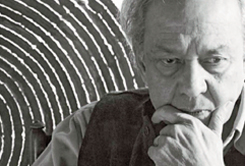
Syed Haider Raza’s art was meditative, emotional and personal
“Bindu is a source of energy, source of life. Life begins here, attains infinity here.” —S H Raza, 1922-2016
When Raza sa’ab, one of the country’s foremost modern painters, also a founding member of the Progressive Artists’ Group, passed away on July 23, 2016, it was truly, as many in the world of art described, “end of an era”. Barely a week before his passing away, the editor of this magazine and the columnist had been discussing how it would be wonderful to have a write-up on Syed Haider Raza, the artist who made the bindu (the dot) his leitmotif.
His contribution to the world of art has been truly phenomenal, his own artistic journey to evolve as one of India’s biggest painters, exceptional, and even when one spoke of market forces, the pull of Raza sa’ab has been tremendous. He became one of India's priciest modern artist on June 10, 2010, when his seminal work, Saurashtra, sold for Rs 16.42 crore ($3,486,965) at a Christie's auction.
Unfortunately, we are now writing an obituary on the artist who gave Indian art a new direction and contributed to it in a vital way. Making France his home for six decades, Raza sa’ab’s absence from his homeland is what allowed him to express his angst visually. “It is India that was his magnificent obsession in all his waking hours and indeed, as he often confessed, in the dreams that haunted him after he fell asleep,” Dilip Padgaonkar mentioned about him. Staring at the landscape of Gorbio, a village in south of France where he lived with his artist wife, Janine Mongillat after they got married in 1959, the artist often found himself reminiscing about India and turned to Kabir dohas, Hindu scriptures, mythological epics, Urdu poetry and folk ballads. “He questioned himself -- ‘Who am I? Where am I?’,” Ashok Vajpeyi, a close friend of Raza sa’ab for the last several decades, said in an earlier interview, which he gave to a Delhi-based private art gallery. Vajpeyi continued visiting him till the artist breathed his last in a private hospital in New Delhi after being in a coma since his birthday in February.
The son of a forest ranger who grew up in Mandla, a village in Madhya Pradesh, it wasn’t surprising that decades later, the lush green forests and the Narmada river (whom Raza sa’ab always referred to as, “Narmadaji” as a mark of respect) featured in several of the artist’s landscapes. In fact, even the iconic bindu, has its genesis in his childhood days when he, as a young, restless child, was asked to meditate on a “dot” that was made on a blackboard of a nondescript classroom by his schoolteacher. “Focus,” the teacher ordered, pointing to the dot he had made with chalk on the board. The six-year-old Raza did and several decades later, the bindu would appear on the canvas in bright reds, Prussian blues, yellows, greens — colours, which, to the artist, signified India and its beauty.
Fame and recognition didn’t come too easily to Raza who struggled for a while to even buy himself paints and brushes and other tools for his art. He studied in Nagpur and then moved to JJ School of Art in Bombay (1943-47). He went to France after being awarded a scholarship from the French government to study at École Nationale Supérieure des Beaux-Arts in Paris between 1950 and 1953. For Raza sa’ab, this phase would be a turning point, allowing him to get exposed to several masters of Western art and turn to the genre of landscapes (he eliminated the human figure in most of his works, unlike several of his fellow artists who were experimenting heavily in the figurative genre). After his studies, he travelled across Europe, and continued to live and exhibit his work in Paris. In 1956, he was awarded the Prix de la critique in Paris in 1956, becoming the first non-French artist to receive the honour.
By the 1960s, Raza sa’ab was delving into “gestural expressionism”, inspired by the works of American artist Rothko. Appointed as a visiting lecturer at the University of California in Berkeley, USA, in 1962, this Rothko-inspired phase was a significant departure from Raza sa’ab’s earlier style, where the artist’s landscapes became impressionistic, reflection of the mind, even as several of them were inspired from the artist’s trips to India. The “colours” of Gujarat and Rajasthan, the energy of Benaras, the sheer artistic supremacy of Ajanta and Ellora caves, all of this served to inspire the artist, prodding him to question his identity, his journey to re-discover his Indian roots. As he commented in one of his earlier interviews: “I didn’t become a French painteror a European one. I remained an Indian painter through the years.”
It was truly in the 1990s, however, that Raza sa’ab introduced the world to something truly extraordinary and pulsating - - the bindu. The sacred, energy-inducing dot gave his canvases a unique profundity and perceptiveness. Full of depth, the dot with bold and evocative geometrical patterns and lines and bright colours allowed the artist’s artistic journey to be transformed dramatically. Raza sa’ab commented on the transformation in an earlier interview: “My work is my own inner experience and involvement with the mysteries of nature and form which is expressed in colour, line, space and light.’
Gaining global reputation, Raza sa’ab returned permanently to India, setting up the prestigious Raza Foundation to help promising artists with funds and sponsorships. The artist who lived to paint and painted to live continued his relationship with colours and canvases until the very end of his life.
